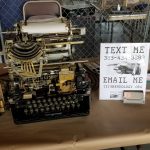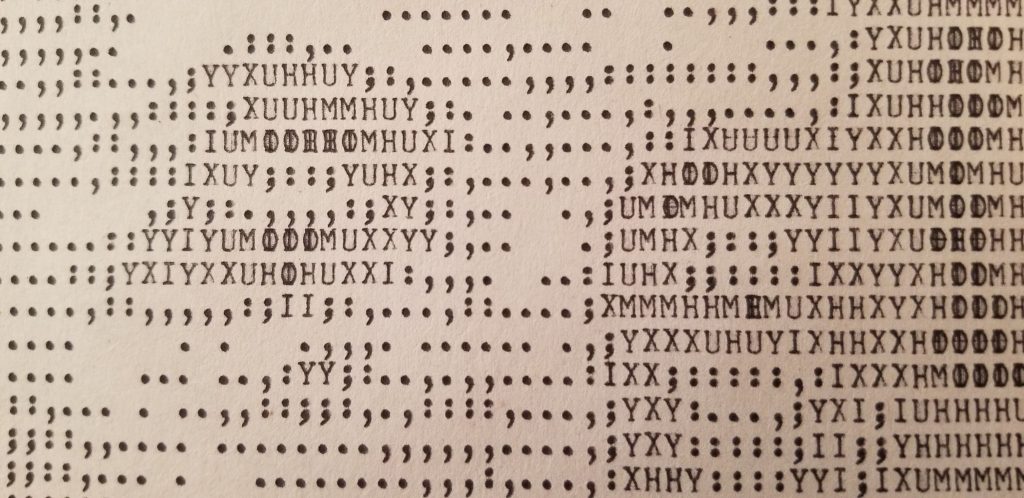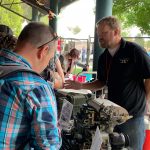Before I get too far in this project, I really ought to write about it before it fades into the aether of a blogless life, much like the Modern Telegraphy Interface Apparatus I built in 2013. I had delusions of writing lengthy and debatably interesting blog posts complete with videos for that one. Well, at least I took pictures.
This will be the introduction or overview, if you will, of the project, with several updates to follow in the coming weeks and months. To start us off on the right foot, here’s a video of some preliminary functionality, for kicks and giggles:
When I was a wee lad in the 90s, I was attracted to my dad’s Macintosh Plus with System 6, my mom’s Packard Bell with Windows 95, and a series of typewriters I procured from the local thrift store, not to mention the AlphaSmart 2000 I had on extended loan from my former 3rd grade teacher. This interest in typewriters continued to the present day when I’ve had to stop talking about it because people keep dumping on me their junk typers that bear no value for me to even try fixing.
This collection of typewriters eventually led me to obtain a few telegraphs and build the Telegraphy Apparatus previously mentioned. This was not enough diving into archaic communications technology, however– I wanted to have the product of the marriage of typewriters and telegraphs. So I procured a US Military AN/UGC-74 in 2016 via eBay. My heart yearned for even earlier communications technology, so in 2017 I tracked down a US Army TG-7A and TT-7/FG (equivalents to the Teletype Model 15 and 19, respectively) from Madison, WI.
For the uninitiated, a teletype (or more internationally accurately known as a teleprinter) is essentially a typewriter that can send and receive signals to and from other teletypes and related equipment like ticker tapes. This enabled rapid communication, overtaking telegraphs in the early 20th century and bleeding into automated systems. Eventually they were used as terminals for early computers and in turn were outmoded by compact computers with keyboards and monitors/printers. Many aspects of modern computers and networks are derived from teletypes, including serial interfaces, the ASCII character set, CR (carriage return), LF (line feed, or newline), the BEL (or alert) character, and the way *nix systems interact with devices named “tty”. There’s much, much more to the history and technology than just this, of course, but I think that’s a good overview.
I got these three teletypes with the end goal in mind of connecting them to the modern internet. I prefer that my antiques be usable rather than just pretty. Now, I am by far not the first to have thought of or done a project like this, and I certainly won’t be the last. It is an enjoyable hobby that makes one wish he worked on technology in earlier times when it was admittedly more interesting than much of the modern, overhyped junk is.
First I needed to either design or find an existing interface to translate between 20 or 60 milliamp, 120-150V DC signals the teletypes produce on a circuit to something a computer could understand. I put a fair amount of thought and research into this thinking I’d utilize something like a Raspberry Pi’s UART, I2C/SPI, or GPIO array in concert with some optoisolators and other supporting circuitry. I decided not to attempt to reinvent the wheel when a helpful friend on the GreenKeys mailing list pointed me to a very good existing design created by another GreenKeys member the year prior.
Once I finally found some time, I was able to acquire all necessary components and then build and program a working prototype on breadboard. Once I worked out a few kinks, I soldered it together. Long story short is that I now have several working interfaces for my several teletypes, controlled by Raspberry Pi.
I’m currently in the process of scripting some functions to perform the following:
- Send and receive email via teletype
- Send and receive SMS via teletype
- SSH out to remote hosts via teletype
- Print RSS feeds on a teletype
- Select and print ASCII (or, more accurately, Baudot-Murray or ITA2) art, commonly called RTTY art (it would technically be a misnomer for me to call it RTTY art since I’m not transmitting it via radio)
- Connect to the ITTY (internet teletype) broadcasting service
- Connect to other internet capable teletypes via TCP, including support for the i-Telex network
- Connect to Living Computer Museum mainframes
- Engage a tape mixer function on transmitted or received messages to emulate the way encryption often was done (these tape mixing machines are quite rare, so I don’t have much hope of obtaining one in the near future)
- Engage an Enigma encryption on transmitted or received messages
- Monitor for incoming messages and turn on and off the teletype motor and current loop as needed
Much of this functionality already exists in software built by other tinkerers, but this is something for which I did want to reinvent the wheel, the reasoning for which I will explain in a future post.
I plan to eventually create a sleek enclosure for the power supply, Raspberry Pi, interface boards, relays, and plugs, and I’d love to build some clear plexiglass cases for the teletypes themselves so the intricacies of the machines can be viewed without them getting dusty, but this will all be a ways out.
I also did some minor restoration work on my machines to get them into ideal operation. Thankfully the prior owners took pride in their machines and kept them in very good condition; in spite of over 40 years of sitting in a basement after the owner went SK, there wasn’t a lot of work necessary, though I definitely still have some additional cleaning, oiling, and greasing to do. My Model 19’s tape puncher and character counter are also not in fully working order due to some electrical issues, and I’m completely missing the M14 TD (tape reader) that normally comes with a Model 19, for which I would gladly pay to complete my set.
Stay tuned for updates on this project including but not limited to:
- Details on the interface design, components, and how it was built
- Details on each teletype’s restoration, cleaning, and maintenance
- Videos of the machines in action
- The coded scripts that run behind the scenes
- Probably other stuff I can’t think of right now



